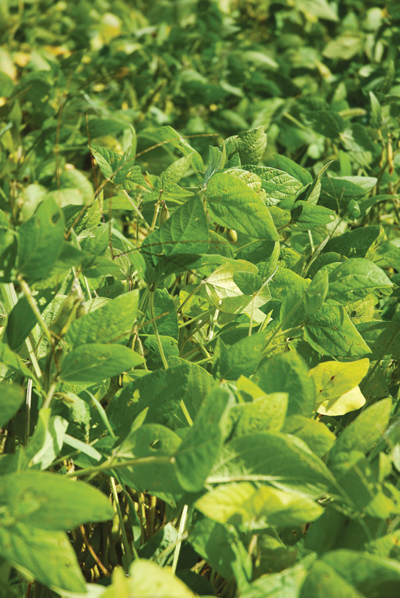
Features
Agronomy
Harvesting
Soybeans in the potato rotation
Nitrate leaching into groundwater, and watersheds and soil degradation
associated with intensive potato production, are critical concerns on
Prince Edward Island, which is dependent on groundwater for its
drinking water.
April 6, 2009 By Heather Hager

|
|
| Soybean is being considered for rotations not just for the agronomics but for the appealing return on investment and ease of management relative to potatoes. |
Nitrate leaching into groundwater, and watersheds and soil degradation
associated with intensive potato production, are critical concerns on
Prince Edward Island, which is dependent on groundwater for its
drinking water. In an attempt to address these issues, the Agricultural
Crop Rotation Act was proclaimed in 2002 to legislate a mandatory
three-year rotation for potatoes and other annual crops that require
high nitrogen inputs. However, difficulties in enforcing the Act have
meant that potatoes may still be grown in some fields every year or
every other year.
Because of the continuing and long-term issue with nitrates in drinking
water, a PEI Commission on Nitrates in Groundwater was established in
July 2007. One year later, the Commission made 30 recommendations to
reduce nitrates in surface and groundwater. A mandatory three-year crop
rotation for potatoes was one of six recommendations that were deemed
absolutely essential.
The typical three-year rotation on the Island has been
potato–cereal–forage, says Brian Beaton, potato industry coordinator
for the PEI Department of Agriculture. Cereals and forages are
currently excluded from regulation under the Agricultural Crop Rotation
Act. “Typically, it has been barley underseeded to a forage in that
second year. The third year would be a forage, breaking up the disease
cycle with a different crop and adding organic matter, and then back in
with potatoes,” says Beaton. However, it is becoming increasingly
unfavourable to plant barley. “In most cases, people are getting away
from barley because it’s not a large revenue generator,” says Beaton.
Robert MacDonald of Belle River, Prince Edward Island, grows 400 to 825
acres of potatoes on a three-year rotation. “The challenge for us has
been to try and find a crop that pays the bills in years two and three
between potatoes,” says MacDonald. He and his two brothers used to
grow barley as the cereal crop, and then tried milling wheat, which had
a slightly better return on investment. But, he says, they were still
looking for something else.
Enter soybeans.
Two factors have increased the appeal of soybeans in the potato
rotation. One is “the higher price compared to the traditional crops
grown on the Island such as barley and feed wheat,” says Beaton. The
other is the construction of a facility to process non-genetically
modified, identity preserved, food-grade soybeans for the Japanese
market by the Atlantic Soy Corp, of which Robert MacDonald is the
president. These latter soybeans currently garner premiums of $45 to
$135 per tonne.
Something else that is attractive about soybeans is that the crop does
not require much management compared to one like potatoes. “Soybean’s a
very low-input crop,” says MacDonald. “It requires very little
fertilizer, very little spray, and very little care. Coming from a
potato background the way we do, it’s quite a shift. With potatoes, we
have to plant, fertilize, spray up to 12 times, harvest and pack them.
With soybeans, we plant, fertilize, spray and harvest them; that’s it.
There’s very little management to it, so it’s a nice crop to grow.”
And a huge investment in new equipment is not required to add soybeans
to the rotation if the producer already grows grains. “Some people take
their grain drill and plug off every second tube and use that to seed
their soybeans,” says Beaton. “You may need to make some minor
modifications to your combine; maybe you need a flex head, depending on
what you already have, or you can get someone to come in and custom
harvest.”
There may be an added cost of drying the harvested soybeans down
further, depending on the moisture level at harvest. This would require
the purchase of a dryer or contracting of the grain elevator to dry the
harvest.
Potatoes and soybeans do share some diseases. “Research has shown that
soybeans in the year prior to potatoes can increase the population of
root lesion nematodes (Pratylenchus penetrans), which can affect
susceptible potato cultivars such as Superior,” says Beaton. “If you
went with soybean for a number of years in a row, it may tend to
increase the root lesion nematode population. It would be no worse,
though, than red clover, which could be in the forage mix.”
Another disease that could be an issue in some years is sclerotinia, or
white mould, which tends to be common with both potatoes and soybeans
in a moist climate, says Beaton.
There are a decent number of good-yielding varieties that are suitable
for Prince Edward Island’s 2400–2700 range of crop heat units. “And
there have been some more low heat unit soybean varieties come on in
the last few years,” says Beaton. In 2008, the average yield for
soybeans on the Island was about 33.7 bu/ac. For comparison, Ontario’s
average yield is estimated at 43.4 bu/ac, the province’s second highest
on record.
| Canola in the potato rotation? | ||
| Another crop is gaining attention for use in the Prince Edward Island potato rotation: canola. “We have a short season, especially when it comes down to harvest at the end, but there are some more canola varieties coming on that are suited to this climate,” says Brian Beaton, Potato Industry Coordinator for the PEI Department of Agriculture. “When you have to swath it and then leave it in the field to dry down, with our dews coming on in the fall, it tends to be harder to get it to dry.” So shorter varieties that mature earlier can facilitate a successful harvest. Potential markets include crushing for canola oil and canola meal and the manufacture of biodiesel or ethanol. |